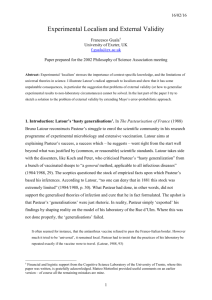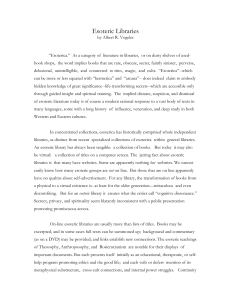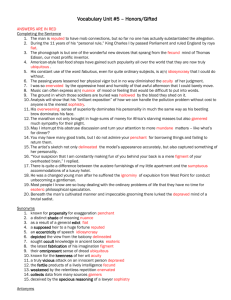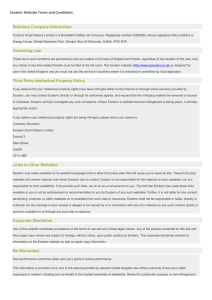notes
advertisement
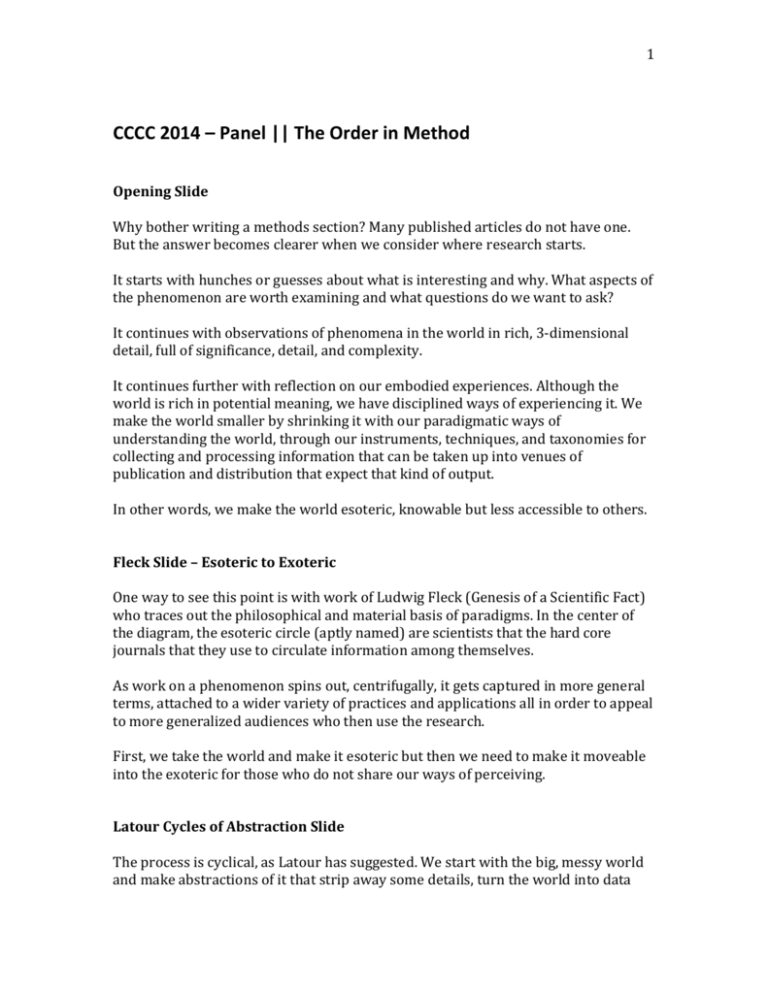
1 CCCC 2014 – Panel || The Order in Method Opening Slide Why bother writing a methods section? Many published articles do not have one. But the answer becomes clearer when we consider where research starts. It starts with hunches or guesses about what is interesting and why. What aspects of the phenomenon are worth examining and what questions do we want to ask? It continues with observations of phenomena in the world in rich, 3-dimensional detail, full of significance, detail, and complexity. It continues further with reflection on our embodied experiences. Although the world is rich in potential meaning, we have disciplined ways of experiencing it. We make the world smaller by shrinking it with our paradigmatic ways of understanding the world, through our instruments, techniques, and taxonomies for collecting and processing information that can be taken up into venues of publication and distribution that expect that kind of output. In other words, we make the world esoteric, knowable but less accessible to others. Fleck Slide – Esoteric to Exoteric One way to see this point is with work of Ludwig Fleck (Genesis of a Scientific Fact) who traces out the philosophical and material basis of paradigms. In the center of the diagram, the esoteric circle (aptly named) are scientists that the hard core journals that they use to circulate information among themselves. As work on a phenomenon spins out, centrifugally, it gets captured in more general terms, attached to a wider variety of practices and applications all in order to appeal to more generalized audiences who then use the research. First, we take the world and make it esoteric but then we need to make it moveable into the exoteric for those who do not share our ways of perceiving. Latour Cycles of Abstraction Slide The process is cyclical, as Latour has suggested. We start with the big, messy world and make abstractions of it that strip away some details, turn the world into data 2 that is easier to manipulate and put into papers that can then circulate and reconnect with the world. Distant planets are easier to study as spectral arrays; diseases as collections of lab values, writing as a finite collection of observable practices. The world is also much smaller (fitting on a notecard) and lighter (weighing no more than paper) in these forms. What the methods section represents is the learned ways that we have adopted for making the world into something that we understand. Methods are sets of rules for making observations, reducing their complexity, making sense out of them, and recirculating them for uptake. Methods and Their Importance Slide So why bother with methods? We can be more precise about this now. Smagorinsky Slides Peter Smagorinsky offers that there are three central components to a methods section in which this rhetorical work is done. Go through the slides But let’s come back to a couple of points running through these guidelines. A methods section is supposed to communicate what we did and also communicate a sense of how valid and reliable the outcomes are going to be. As you know, validity refers to the match between what we observe and how we observe it to the thing in the world (how true is the match). Reliability refers more to consistency and the discipline of application. Of course, validity and reliability are a balancing act. We increase one at the expense of the other. So while we make more reliable observations of phenomena if we control where they occur (e.g., in a lab) or if we reduce their complexity in order to make identification or analysis simpler, we increase reliability but decrease validity. Likewise, if we observe a phenomenon “in the wild,” we have to give up on the ability to control what we see and how we might collect data about it that would be comparable from one observation to the next. When we present our methods, we are always telling a story about data collection, reduction, and analysis and making claims about trust and confidence by showing where our choices are valid, reliable, and (in most cases) limited. To drive at that point, let’s consider what the practice looks like in our field. 3 Spectrogram Slides Most of these proceed in a manner that you would expect. They often start with information about data collection, proceed to data reduction, and sometimes end with data analysis. Sprinkled throughout are claims about validity and reliability. Assuring readers that the data collection choices result in sufficiently valid representations of the phenomena being analyzed. Or that choices about data reduction and coding are made reliable through double checking or other verification processes. If researchers are forthcoming about them, there are also comments about the limits that one can take an analysis. We see aspects of all in these three articles. And we can look more closely (time allowing) at some of the techniques used to make the methods work: Data Collection and Validity Slide Claims about the validity of data collection procedures, assure that the participants for the study are representative of the populations or regions about which the analysis makes claims Data Reduction and Reliability Slide And here the purpose is to show that the choices made about data reduction follow a set of accepted principles, like Grounded Theory, or that the process of reduction itself was verified independently by another researcher. Data Analysis and Validity Slide In these passages, the point is to show that the analysis was verified by comparison to the world of data from which the sample was taken and sometimes even actively so, by the people being studied. 4 Limitations Slide Finally, some methods sections offer some perspective on the limitations of the collection, reduction, and analysis. All studies have limitations to them, but the studies differ in terms of how directly they note these limitations. Closing Slide Although there is more nuance to the method section than we have time to cover in the short time that we have here today, it is our hope that this overview clearly lays out some of what is at stake, rhetorically.








